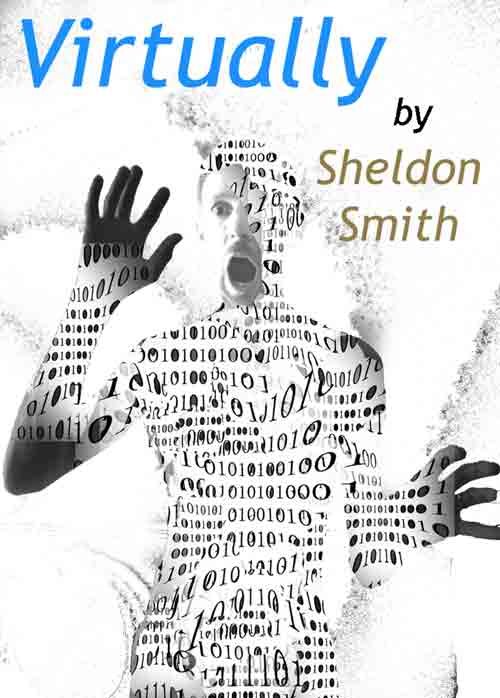ExtractRead the first chapters of the novel Virtually
he half-saw the face again in his mind's eye, caught by fire, the flames corroding the flesh like (don't look! shut it out!)
- if they did that, if they delayed the launch, that would be the end. Of him, and the company. Regardless of whether he was right or wrong. It was a cutthroat business. There was no way they could stall on the 6000-Mk-I so late in its production, especially if Reality Inc. had a similar model coming out.
Were the two models really that similar though? The -
screams in his mind's ear (go away!)
- 6000 series marked their first tentative steps at creating an artificial construct of the human mind. When a VR user hooked up to it, his thoughts and feelings were analysed, his reactions gauged, a crude map of his mind was encoded via the encephalocoder and stored on disc. Each time he used the system, the emotive/reactive map was updated, allowing a personality profile to be gradually built up and enabling the VR to be tailored much more specifically.
The 7000 series, however, went way beyond that. As well as personality traits, it mapped the VR user's memories, to create, as near as could be, a digitized copy of the userí»s mind. Think of it: rather than an off-the-peg reality, meant to please as many as possible, a unique reality could be created, tailored - just as with the 6000, except much more completely - to the individual himself.
The single biggest drawback was fantasy. It always had been, though in the very first VR simulators it was the greatest selling point. What use was it otherwise? The obese could slip into slimmer bodies and have the time of their lives, the paralysed could walk again. But always, beyond the curtain of fantasy, lay the reality they were escaping, into which they would have to re-emerge, finding themselves once again swaddled in layers of fat or wheelchair-bound. A taste of freedom made imprisonment that much harder to bear. The suicide rate had soared amongst the physically challenged. Lawsuits had been filed. The reparations were huge. Times had been hairy - of the conglomerate of companies who had pooled efforts and resources in designing the first truly immersive VR simulators, only Virtual Enterprises and Reality Inc. had come through them.
As a result, research had been poured into fantasy-free simulations. That was half the point of the 6000 series: the "virtual" you bore an uncanny resemblance to the "real" you. Same with the 7000, except of course, to all intents and purposes, it was you. If you wanted to slip out of your body, to shed pounds, grow limbs, become someone better endowed in looks and charm and anything else you fancied, then it could be done. Just stick with the old Inc. and Enterprises models. Which would soon be phased out, possibly outlawed. The future was the 7000 series, VR involving a carbon copy of you. Unfortunately, the old problem couldn't be shaken off. Fantasy was still there. The subjects tested to date (comprising mainly Martin and J. himself - they were their own guinea pigs) had shown a marked desire for nostalgia. Why not? The memories were already there, encrypted on disc via the encephalocoder. Activating a stored memory was easier than creating a VR from scratch and much more detailed to boot. The VR simulator became a time machine, enabling the VR user to escape reality by returning to the past and reliving a pleasant memory. The problem was, the past became warped. Unpleasant aspects were deleted, more desirable ones added. A bittersweet recollection of unrequited love could be changed: this time round, you would get the girl. Despite the possible attractions, it was something they were at pains to eradicate. There was a danger the subject could become delusional.
Was that what had happened to him? Had one of his memories been twisted and reshaped? Something wholesome refracted through the prism of VR and distorted beyond belief? It was a frightening proposition, to say the least: instead of one of his memories being rewritten and replaced with an untrue copy, the two had been placed side by side. Except not side by side, the original placed on top, concealing the copy beneath. A whole network of false memories might lie embedded in his mind, a Mr. Hyde personality lying undetected and waiting to burst forth.
All the same, he didn't quite believe it. Possible. Unlikely. It was more probable that some dark secret had been unlocked, a repressed memory dredged up rather than created from scratch. This was something they had never anticipated. And given the make-up of the 6000 model, encoding emotion rather than memories, it was unlikely in the extreme that it would have any bearing.
One thing still bothered him though: Anne-Yvonne. He didn't know her, and yet the memory seemed to involve her. Was she simply a catalyst? The chemical bonds holding the memory in place were breaking down - how, why, who could say - and something about her, some parallel, her voice echoing another voice, had hastened that reaction.
Or so he believed. He couldn't, he was glad to say, know for certain, his diversion having worked: his pulse had settled into a normal rhythm and the impish remnants of that flash of death had all slunk away.

Available for purchase now
Buy the e-book version of Virtually online via Amazon.co.uk (UK readers), and Amazon.com (North America).
The paperback version is available
in the UK from Amazon.co.uk and in North America from Amazon.com.








